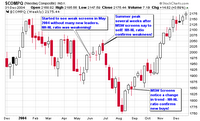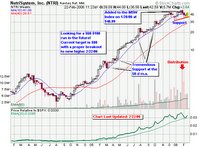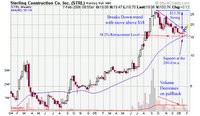 As I highlighted in the blog post yesterday, my system alerted me that the market was going to take a turn south in the summer of 2004 and it did (May, June and July). It is important for every trader to have your own system that alerts you of moves which allows you to profit. It can be short term, long term or anything in between but you must understand what it is saying. I depend on the price and volume of the major indexes, the NH-NL ratio and the action among the individual leaders to determine if the market is strong or weak. Since I have studied these patterns for years, I know when the market is moving higher or lower based on the confirmations each of these indicators give me. Nothing is exact but they are extremely accurate as they guide me with test buys, position sizing my trades and moving me to the sidelines.
As I highlighted in the blog post yesterday, my system alerted me that the market was going to take a turn south in the summer of 2004 and it did (May, June and July). It is important for every trader to have your own system that alerts you of moves which allows you to profit. It can be short term, long term or anything in between but you must understand what it is saying. I depend on the price and volume of the major indexes, the NH-NL ratio and the action among the individual leaders to determine if the market is strong or weak. Since I have studied these patterns for years, I know when the market is moving higher or lower based on the confirmations each of these indicators give me. Nothing is exact but they are extremely accurate as they guide me with test buys, position sizing my trades and moving me to the sidelines.
Take a look at how these three major indicators got me in and out of the market in 2004 (and keep in mind that I am not a day trader – I was momentum trading, trend trading and swing trading in 2004 – which ever you would like to call it).
I wrote this entry on my Weekly Screens on April 19, 2004 (the highs on the NASDAQ in April 2004 were not revisited until November of that year):
“Market Overview: The market is still in a confirmed rally according to rules but we are seeing many stocks hesitate and undecided about their direction. The world situation has been a big influence on the general market conditions. Speculation of an interest rate hike has kept the market in flux.
My screens showed bad news last week with the daily new highs and lows. For the first time since posting my screens in November (2003), the daily new highs were lower than the daily new lows. I haven’t seen action like this since the bear market.”
I posted a weekly screen insert in yesterday’s blog post from July 2004 which warned that the market was still heading lower. The MSW screens turned negative in May 2004 and stayed that way until late August 2004 as you will read below.
WEEKLY OVERVIEW of 8/16/04 to 8/20/04:
“…However, I am possibly seeing a new trend that may be starting to form in the indexes. You heard it here first. I may be early but I am seeing a change in my screens. (Please note, I saw the trend in March of 2003, especially April of 2003 – I posted in real time on this breakout simultaneous with IBD). I was tipped off by the “new highs vs. new lows” combined with the huge institutional sponsorship that was sending stocks to new highs.
The DOW was up just short of 3% from Friday (13th) to this past Friday (20th)
The NASDAQ was up 4.5% in the same time period
I have noted that volume was extremely weak.
The New Highs vs. New Lows picture looked different than past weeks.
We had 3 days out of 5 that had more new highs.
On 8/13, we had – NH-37, NL-304
On 8/20, we had – NH-128, NL-53
I know this is minor but it may be the first signs of a changing atmosphere. Stayed tuned as I will keep a close eye on this change in my screens. (I have done my daily analysis for Monday, August 23, and I see more encouraging signs in the NH vs. NL list: 131 vs. 46). Again, volume was weak. When the charts and volume cooperate with the new highs list, we may be half way to a new up-trending market.”
Looking at the chart from 2004, I guided traders out near the top of the early summer decline and I guided them back in at the beginning of the late summer/ fall advance.
More recently, I took investors out of the market in mid May 2006 and hope to have them back in when my screens confirm the rally in the future. When will that be? I don’t know but my research will tell me as it has every time in the past.
If you would like to review my work on the MSW screens, I invite you to explore my past archives from 2004 and 2005 as they are open to the public. You can review a chart as you read everything I have written over the past two years. The archives for 2006 are for members only but will open to the public when the year ends. Using my three main indicators, I have been very successful by getting in and out of the market since late 2002. Prior to 2002, my system was not as strict as it is today but I learned my lesson by getting slammed in 2001.
Develop a system, hone that system and understand what it is trying to tell you and you will come out with a profit. Every trade can’t be a winner but you won’t be fighting the trend because your overall system will tell you what side of the market to trade.
Piranha



Connect with Me